Screen printing mesh is a crucial part of getting high-quality prints. It controls the amount of ink that passes through and determines how sharp or detailed your design will be. Choosing the right mesh can make all the difference in your final product. In this guide, we’ll explore the types of mesh, how to select the best one for your project, and tips for maintaining your screens.
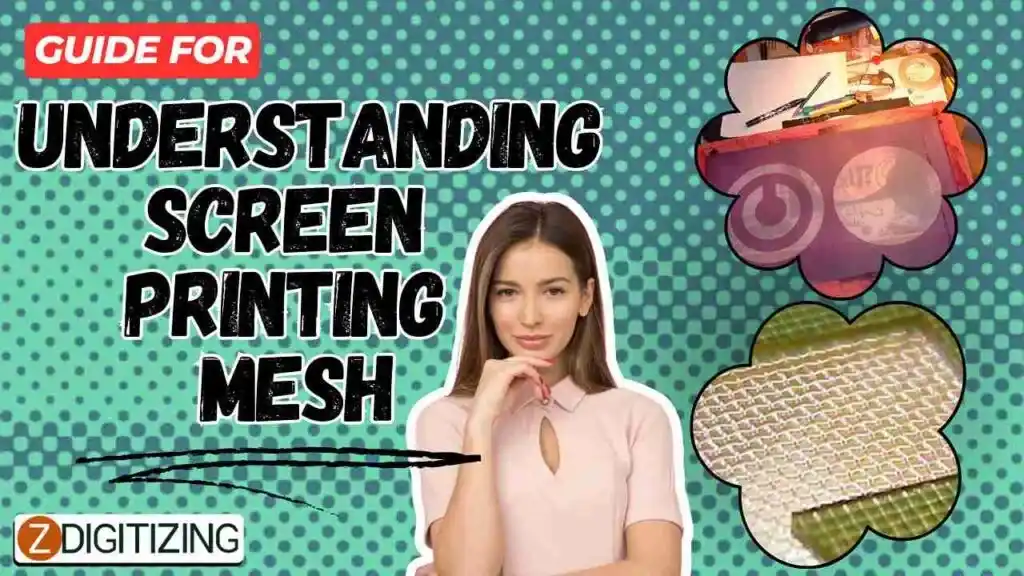
Understanding these basics will help you improve your printing results and avoid common mistakes.
Guide For Understanding Screen Printing Mesh
What is Screen Printing Mesh?
It is a woven fabric made from materials like polyester, nylon, or stainless steel, used in the screen printing process to transfer ink onto a substrate. The mesh is stretched tightly over a frame, with varying mesh counts determining the level of detail and ink flow in the printed design.
Types of Printing Mesh Materials
It comes in various types, each offering different advantages depending on the application. Below are four common types of mesh materials used in screen printing.
- Nylon Mesh
- Polyester Mesh
- Stainless Steel Mesh
- Silk Mesh
Embroidery Digitizing & Vector Art Services
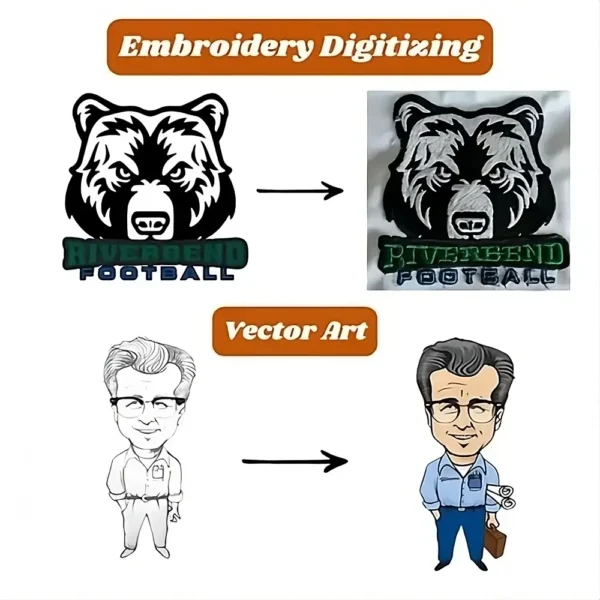
Looking for embroidery digitizing and vector art services that are affordable and reliable? We offer fast turnaround time, guaranteed quality, and the option to preview your design before payment, we make sure you get exactly what you need. Your satisfaction is our top priority, and we’re dedicated to delivering the best results. Don’t wait—try ZDigitizing today and see the difference in quality and service!
Embroidery Digitizing & Vector Art Services
Looking for embroidery digitizing and vector art services that are affordable and reliable? We offer fast turnaround time, guaranteed quality, and the option to preview your design before payment, we make sure you get exactly what you need. Your satisfaction is our top priority, and we’re dedicated to delivering the best results. Don’t wait—try ZDigitizing today and see the difference in quality and service!
1. Nylon Mesh
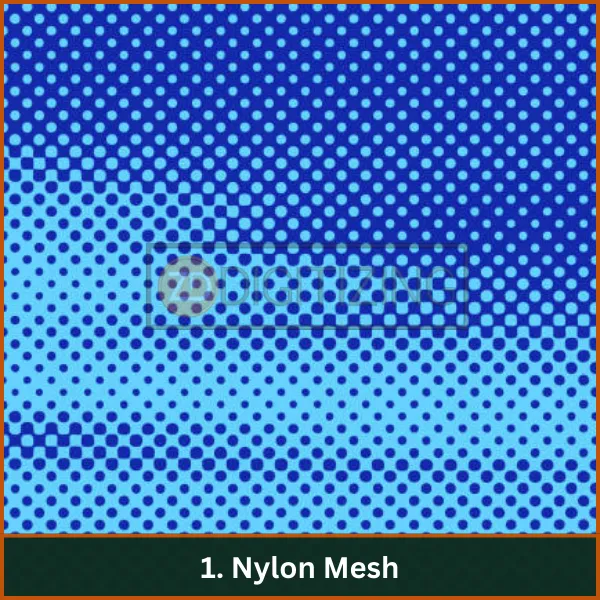
It is a flexible and stretchable material used for screen printing, known for its ability to print on curved and uneven surfaces.
Features:
- Highly flexible
- Great elasticity
- Suitable for curved or uneven surfaces
Pros and Cons:
Pros |
High flexibility and stretchable |
Ideal for printing on fabrics |
Works well with water-based inks |
Cons |
Prone to stretching over time |
Less durable than polyester or steel |
Can lose tension after multiple uses |
Applications:
- Printing on textiles, including t-shirts, bags, and fabrics
- Printing on uneven or curved surfaces (e.g., caps, bottles)
- Use in flexible or high-stretch fabric designs
2. Polyester Mesh
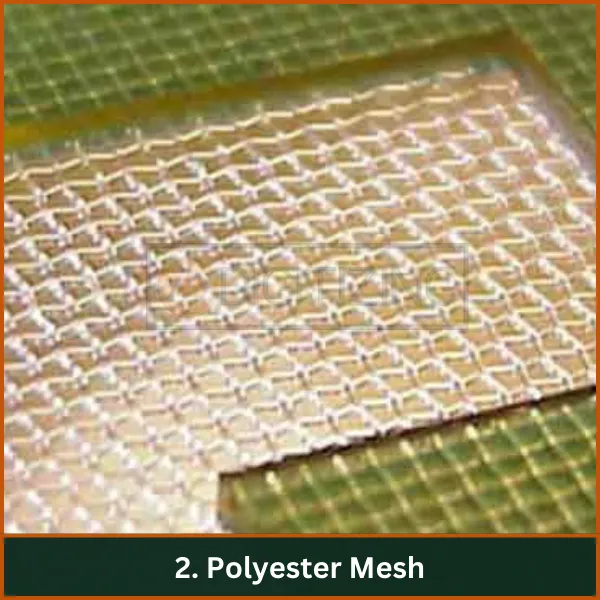
It is the most commonly used material for screen printing due to its durability and ability to maintain stable tension during printing.
Pros and Cons:
Pros |
Durable and resistant to chemicals |
Holds tension well for consistent prints |
Works well with a variety of inks |
Cons |
Not as flexible as nylon |
Can be more expensive than nylon |
Prone to wear over time with harsh inks |
Applications:
- General screen printing (e.g., posters, fabrics)
- Printing on flat surfaces and textiles
- Ideal for long-run printing jobs
3. Stainless Steel Mesh
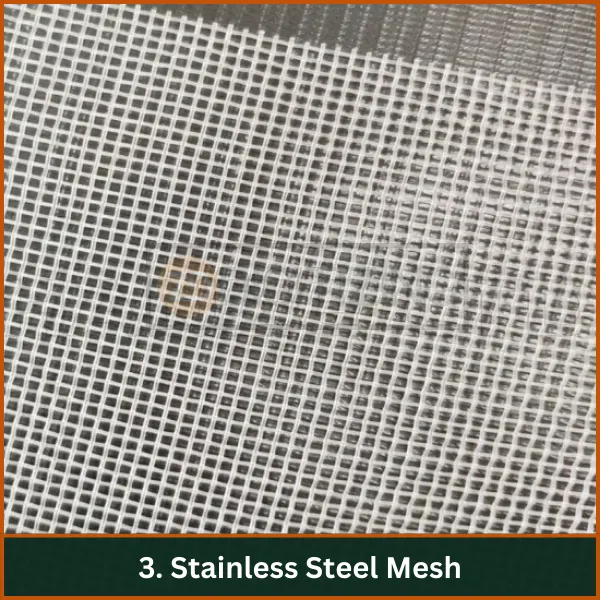
It is a strong and rigid material used for high-precision and industrial screen printing applications, offering durability and resistance to harsh conditions.
Features:
- Extremely durable and rigid
- High precision for detailed printing
- Resistant to heat and chemicals
Pros and Cons:
Pros |
Very durable and long-lasting |
Great for fine detail and industrial applications |
Ideal for high-precision printing |
Cons |
Expensive compared to nylon and polyester |
Less flexible and harder to adjust |
Difficult to work with on uneven surfaces |
4. Silk Mesh
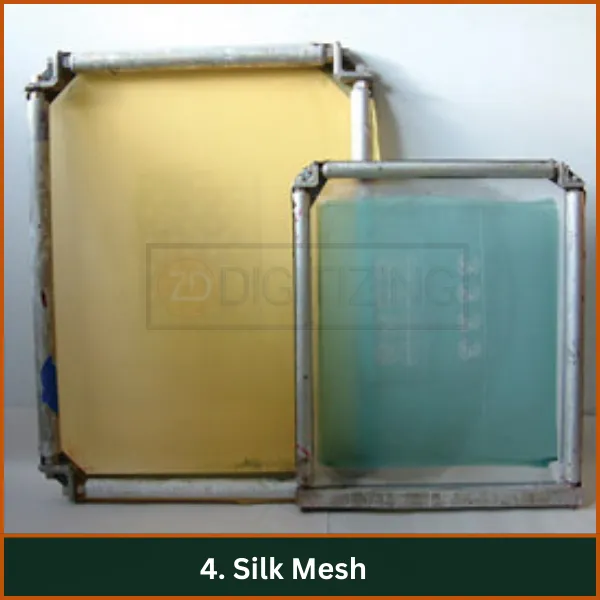
It is a traditional screen printing material used primarily for fine-art and artistic printing projects, offering smoothness but less durability compared to modern materials.
Features:
- Smooth texture for high-detail printing
- Traditionally used in screen printing
- Less common in modern commercial use
Pros and Cons:
Pros |
Great for artistic and fine-detail prints |
Smooth surface for even ink distribution |
Ideal for water-based inks |
Cons |
Less durable than modern materials like polyester |
More expensive and harder to source |
Not suitable for long production runs |
Applications:
- Artistic and traditional screen printing
- High-detail, small-run printing projects
- Suitable for water-based inks in fine art or limited-edition prints
Understanding Mesh Count
Mesh count refers to the number of threads per inch in a screen used for printing. It is important to determine how much ink passes through the screen and how detailed the design can be in a mesh screen print.
What is Mesh Count?
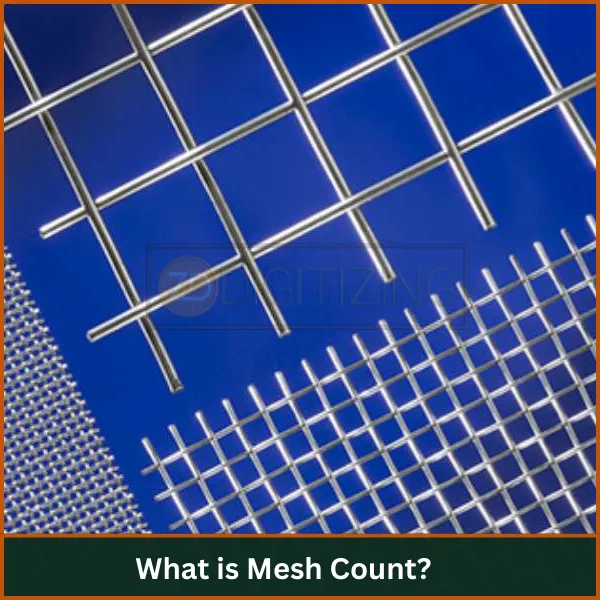
It is simply the number of threads in one square inch of the screen. A higher mesh count means there are more threads in the screen, which allows for more detailed designs but less ink flow. Lower mesh counts have fewer threads, allowing more ink to pass through but with less detail.
Common Mesh Count (with Applications)
Here are the different common mesh counts used in screen printing, along with their typical applications:
1. 40 to 60 Mesh Count
This very low mesh count is used for printing heavy inks, such as those with special effects like glitter, shimmer, or puff inks. It allows large amounts of ink to pass through the screen.
Applications:
- Glitter prints
- Puff inks
- Shimmer prints
2. 80 to 110 Mesh Count
This low mesh count is ideal for printing bold designs with thick ink coverage, such as metallic prints or bold, simple designs on dark fabrics.
Applications:
- Bold designs on dark fabrics
- Metallic ink prints
- Printing on thicker substrates like paperboard
3. 155 to 200 Mesh Count
This mid-range mesh count is the most commonly used for general mesh screen print applications. It strikes a balance between ink flow and design detail, suitable for standard t-shirt printing and posters.
Applications:
- T-shirt printing
- Poster printing
- General fabric printing
4. 230 to 280 Mesh Count
This higher mesh count is used when finer detail and smoother ink coverage are required. It works well with thinner inks like water-based inks or for prints that need fine detail.
Applications:
- Fine detail prints
- Water-based ink prints
- Small text or logo prints
5. 305 to 355 Mesh Count
This very high print screen mesh count is perfect for printing highly detailed designs. It’s typically used for intricate designs, halftones, and fine lines, often on light fabrics or smooth materials.
Applications:
- Halftone prints
- Highly detailed logos and designs
- Printing on smooth, light fabrics
How Mesh Count Affects Printing
The mesh count directly affects the amount of ink that passes through the screen and the detail of the design. A low mesh count allows more ink to pass through, which is great for bold prints but not for detailed work. On the other hand, a high mesh count lets less ink through but creates sharper, more detailed designs. This makes it important to choose the right mesh count for each project based on the desired print quality and ink type.
Factors to Consider When Selecting Mesh for Screen Printing
When selecting the right screen printing mesh, there are several key factors to keep in mind to ensure optimal printing results.
1. Mesh Count
Definition: The number of threads per inch in the mesh fabric.
Impact:
- Higher mesh counts (e.g., 230 or above) are ideal for fine details and thinner inks.
- Lower mesh counts (e.g., 110) allow for more ink deposition, suitable for bold designs.
- Choosing the right mesh count is critical to avoid issues like ink bleeding or insufficient coverage.
2. Ink Type and Viscosity
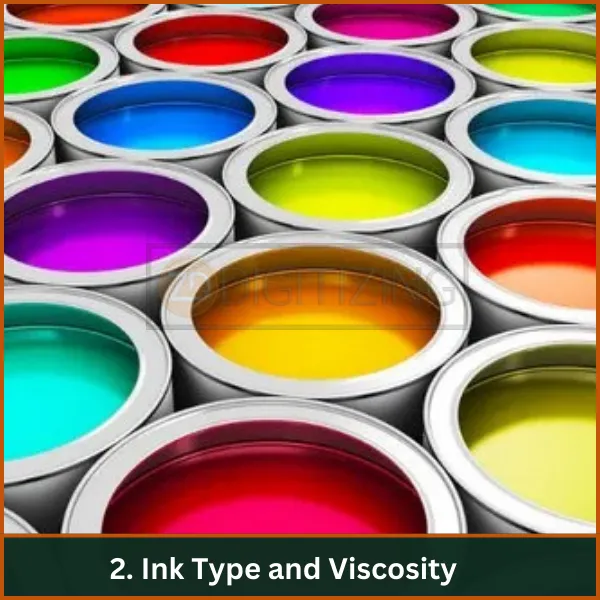
Thicker Inks: Lower mesh counts are better for thicker inks, such as plastisol, to ensure adequate coverage and opacity.
Thinner Inks: Higher mesh counts work well with thinner inks, like water-based inks, preventing flooding and ensuring the retention of fine details.
3. Design Detail
- High Detail: Intricate designs require higher mesh counts to prevent fine lines from falling through the larger openings of lower counts.
- Low Detail: Simple, bold designs can be printed effectively with lower mesh counts, allowing for greater ink flow.
Embroidery Digitizing & Vector Art Services

Looking for embroidery digitizing and vector art services that are affordable and reliable? We offer fast turnaround time, guaranteed quality, and the option to preview your design before payment, we make sure you get exactly what you need. Your satisfaction is our top priority, and we’re dedicated to delivering the best results. Don’t wait—try ZDigitizing today and see the difference in quality and service!
Embroidery Digitizing & Vector Art Services
Looking for embroidery digitizing and vector art services that are affordable and reliable? We offer fast turnaround time, guaranteed quality, and the option to preview your design before payment, we make sure you get exactly what you need. Your satisfaction is our top priority, and we’re dedicated to delivering the best results. Don’t wait—try ZDigitizing today and see the difference in quality and service!
4. Substrate Material
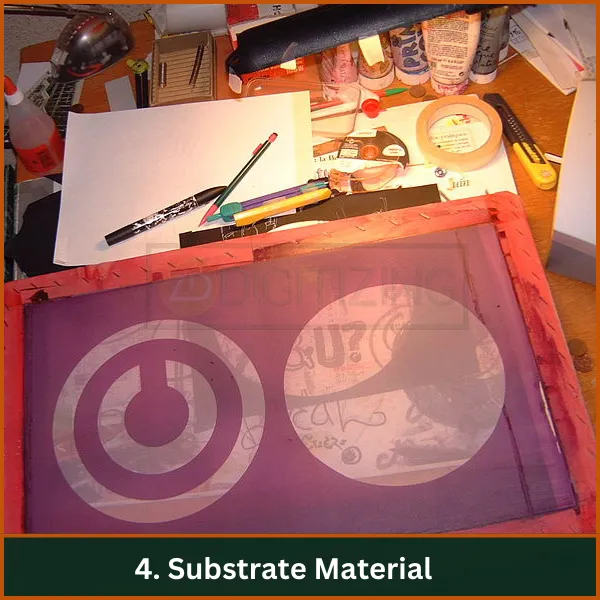
Different substrates may require different mesh counts for optimal printing results:
- Textiles: Lower mesh counts are needed for better ink adhesion.
- Paper or Smooth Surfaces: Higher mesh counts are preferable to maintain fine details without flooding the surface.
5. Tension
- Proper tension in the mesh is crucial for even ink distribution and to avoid smudging or blurring during printing.
- A well-tensioned screen helps maintain consistent print quality.
6. Mesh Material
- Polyester: Most common choice due to flexibility and chemical resistance.
- Silk: Traditional but less common in modern printing.
- Nylon and Metal: Offer specialized benefits for specific applications, such as high durability or precision printing.
7. Frame Type
- Wood frames: Less durable, may lose shape over time.
- Aluminum frames: More durable, maintain shape better, suitable for long-term use.
Caring for and Cleaning Your Screen Printing Mesh
Proper care and cleaning of your printing mesh are essential for maintaining print quality and extending the life of your screens. If screens are not cleaned and handled correctly, they can become clogged, damaged, or less effective over time.
Here’s how to care for and clean your mesh:
- Remove Excess Ink: Use a squeegee to scrape off excess ink before it dries.
- Use the Right Cleaning Solution: Choose a cleaner suitable for your ink type, and avoid harsh chemicals to protect the mesh printing screen.
- Rinse with Water: Rinse thoroughly with water, using a pressure washer if needed.
- Dry the Screen Completely: Ensure the screen is completely dry before storing to prevent mold or damage.
- Store Properly: Keep screens in a cool, dry place, stored upright or in a rack to avoid bending or warping.
Conclusion: Mastering Screen Printing Mesh for Better Results
Understanding screen mesh for printing is key to producing high-quality prints with the right amount of detail and ink flow. By choosing the correct mesh and maintaining it properly, you can ensure that your designs come out exactly as you envision.
Whether you’re working on bold designs or fine details, selecting the right mesh is essential for achieving the best results.
At ZDigitizing, we also offer professional vector art services to complement your screen printing projects. With our fast turnaround time, affordable pricing, and high-quality designs, we help bring your ideas to life quickly and efficiently.
Plus, as a special offer, new customers can enjoy 50% off their first order! Get in touch today to elevate your printing projects with top-notch vector designs.
FAQs
Yes, you can screen print on mesh shorts, but it requires a well-adjusted off-contact distance and possibly a backing material to prevent ink bleed.
Choosing the mesh count for screen printing depends on the detail of the design and the viscosity of the ink; finer details and thinner inks typically require a higher mesh count.
To clean screen print mesh, gently use a screen wash or emulsion remover, scrub lightly with a soft brush, and then rinse thoroughly with water.
To expose screen printing mesh, coat it with a light-sensitive emulsion, let it dry, place your design on the screen, and then expose it to a UV light source for the recommended time.












